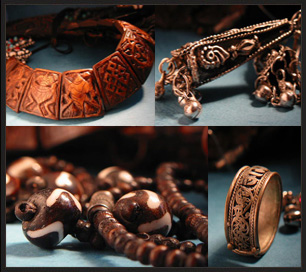|
Parasol, Chinese Parasol, Parasol Umbrella, Tibetan Parasol, Parasol Umbrellas,Tibet Artwork, Tibetan Silver Jewelry , Tibetan Jewelry, Tibet Jewelry, Jewelry from Tibet, Tibetan Buddhist Jewelry, Tibetan Turquoise Jewelry, Tibetan Jewelery
Tibet Artwork, Tibetan Silver Jewelry , Tibetan Jewelry, Tibet Jewelry, Jewelry from Tibet, Tibetan Buddhist Jewelry, Tibetan Turquoise Jewelry, Tibetan Jewelery, Buddhist Jewelry
|
|
The parasol or umbrella (Skt. chattra; Tib. gdugs) is a traditional Indian symbol of both protection and royalty. The ability to protect oneself against inclement weather has always, in all cultures, been a status symbol. In Europe, until a few decades ago, a sunshade was a status symbol for society ladies. In Oriental thought, the fact that it protected the bearer from the scorching heat of the sun was transferred into the religious sphere as a "protection against the heat of defilements." Thus the coolness of its shade symbolizes protection from the heat of suffering, desire, and other spiritually harmful forces.
The dome of the umbrella is held aloft by a vertical handle (just like the mountain upholds the sky), which is identified with the 'axis mundi,' or the central axis upholding the world. The umbrella is carried above an important dignitary or the image of a deity, to indicate that the person or symbol below the umbrella is in fact the center of the universe, and also its spiritual support. Umbrellas seem to be especially important in processional rites, being like mobile temples. Thus, depictions of the Buddha often display an elaborate and large umbrella above his head.
As it is held above the head it naturally symbolizes honor and respect. In Vajrayana Buddhism, this large umbrella (atapatra) was even deified into the thousand-armed, -footed goddess Sitapatra, whose name literally means 'the white umbrella.'
In Tibet, depending on their status, various dignitaries were entitled to different parasols, with religious heads being entitled to a silk one and secular rulers to a parasol with embroidered peacock feathers. Exalted personalities such as the Dalai Lama are entitled to both, and in processions, first a peacock parasol and then a silk one is carried after him.
The Tibetan version of the parasol was adopted from its royal Indian and Chinese prototypes, and fashioned from a wooden, spoked frame with a domed silk cover and hanging silk pendants making up an overhanging skirt.
The dome symbolizes wisdom, and the hanging skirt, compassion. Thus the composite form of the parasol signifies the union of these dual elements.
Octagonal and square parasols are also common, representing the Noble Eightfold Path and the four directional quarters respectively.
--------------------------------------------------------------------------------------------------------
Labels: Parasol, Chinese Parasol, Parasol Umbrella, Tibetan Parasol, Parasol Umbrellas,Tibet Artwork, Tibetan Silver Jewelry , Tibetan Jewelry, Tibet Jewelry, Jewelry from Tibet, Tibetan Buddhist Jewelry, Tibetan Turquoise Jewelry, Tibetan Jewelery
|
Buddhist Symbols
In the earliest centuries of Buddhism, statues of the Buddha were not used. Instead, Buddhist art consisted of images symbolizing the Buddha and his teachings, such as the lotus, the Wheel of the Law, the Bodhi tree and the Buddha's footprints.
Eventually, the Buddha image became one of the most popular representations in Buddhism, but these early symbols remain important and are frequently used to this day. They are especially important in Theravada Buddhist countries like Sri Lanka and Thailand.
As Buddhism spread, Buddhist symbolism was enriched by the cultures it came into contact with. This is especially true of Buddhism in Tibet, which has developed a rich symbolic tradition. The central symbols of Tibetan Buddhism are the Eight Auspicious Symbols, known in Sanskrit as Ashtamangala (ashta meaning eight and mangala meaning auspicious). The Eight Auspicious Symbols are printed on Tibetan prayer flags, incorporated into mandalas and thangkas, and used in other forms of ritual art. Another important symbol is the Wheel of Life, a symbolic representation of the universe as understood by Tibetan Buddhists.
Other important types of symbolism in Buddhism include colors, especially the five colors of white, yellow, red, blue and green, and symbolic hand gestures called mudras. The articles in this section explore these Buddhist symbols, providing information on their history, meaning and use in Buddhism today. (For an introduction and quick guide to Buddhist colors, see our Chart of Buddhist Color Symbolism.)
|
|




添加新评论